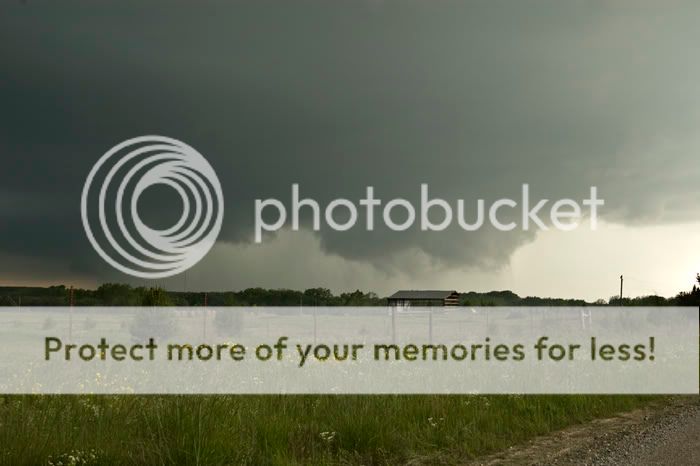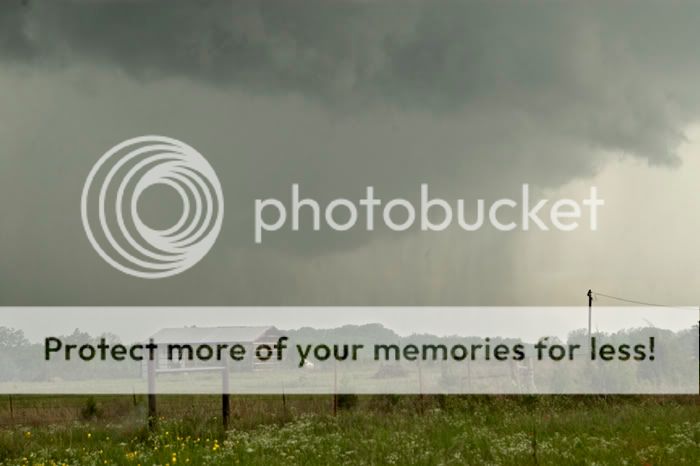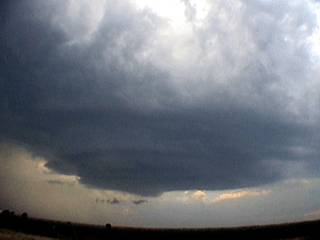Jeff Bartlett
EF0
I guess this could go in the Reports area, but it is more of a question than a report at this time.
This is the second time that I have seen this and I have plenty of questions for most of you who have a much better understanding of meteorological phenomena than myself.
How does a meso and potential tornado form on the north side of a storm? These two experiences fly in the face of conventional chaser/spotter wisdom, from everything that I have learned. The north side of a storm is not receiving the "juice" typically required to sustain tornado development.
The first time I saw this was May 2nd, 2006 just to the west of Hammon, OK. I was observing the storm to my west when this feature became rather evident and produced several small funnels before it (for the lack of a better term) occluded around into the northern side of the storm and disappeared.

I always thought this to be rather odd, and then yesterday I witnessed almost an identical situation. The initial storm development was linear in nature and quite unimpressive from my point of view. But then from the south of Prague, OK I was able to observe this feature as the linear storm seemed to seperate. The bulk of the precipitation had moved off to the northeast, and this secondary "tail-end charlie" seemed to sit and churn in the same area for a little while. This area of defined rotation was enough for someone in the Prague area to sound the tornado sirens, which I could hear to my north. It was wrapping up pretty tight and also produced some funnels, but just couldn't pull the trigger.

But this meso/wall-cloud was on the northern-most edge of the now discrete storm. It then became rain-wrapped and then also occluded into the main body of the storm.

This is then the storm that would go on to produce other wall-clouds/funnels/etc. along I-40, but by then, those features were of a more traditional fashion (i.e., southern, southeastern portion of the supercell with a good source of inflow).
I ask this here because, as a long time lurker and rare poster, I highly respect the knowledge base present on this forum. I have learned so much from this forum for many years now and I value the opinions of the more experienced members of this board. Any help here would be much appreciated.
This is the second time that I have seen this and I have plenty of questions for most of you who have a much better understanding of meteorological phenomena than myself.
How does a meso and potential tornado form on the north side of a storm? These two experiences fly in the face of conventional chaser/spotter wisdom, from everything that I have learned. The north side of a storm is not receiving the "juice" typically required to sustain tornado development.
The first time I saw this was May 2nd, 2006 just to the west of Hammon, OK. I was observing the storm to my west when this feature became rather evident and produced several small funnels before it (for the lack of a better term) occluded around into the northern side of the storm and disappeared.

I always thought this to be rather odd, and then yesterday I witnessed almost an identical situation. The initial storm development was linear in nature and quite unimpressive from my point of view. But then from the south of Prague, OK I was able to observe this feature as the linear storm seemed to seperate. The bulk of the precipitation had moved off to the northeast, and this secondary "tail-end charlie" seemed to sit and churn in the same area for a little while. This area of defined rotation was enough for someone in the Prague area to sound the tornado sirens, which I could hear to my north. It was wrapping up pretty tight and also produced some funnels, but just couldn't pull the trigger.

But this meso/wall-cloud was on the northern-most edge of the now discrete storm. It then became rain-wrapped and then also occluded into the main body of the storm.

This is then the storm that would go on to produce other wall-clouds/funnels/etc. along I-40, but by then, those features were of a more traditional fashion (i.e., southern, southeastern portion of the supercell with a good source of inflow).
I ask this here because, as a long time lurker and rare poster, I highly respect the knowledge base present on this forum. I have learned so much from this forum for many years now and I value the opinions of the more experienced members of this board. Any help here would be much appreciated.







